Pencil cactus plants look like they would be fussy, but they’re actually very easy to grow and care for.
Their unique appearance makes them a fun and interesting addition to any plant collection, indoors or out.
But to enjoy it for as long as possible, you first need to learn how to care for a pencil cactus properly.
This guide is designed to help you do just that. Below I’ve included everything from the sun, water, fertilizer, and temperature requirements to how to manage pests, diseases, pruning, and more.
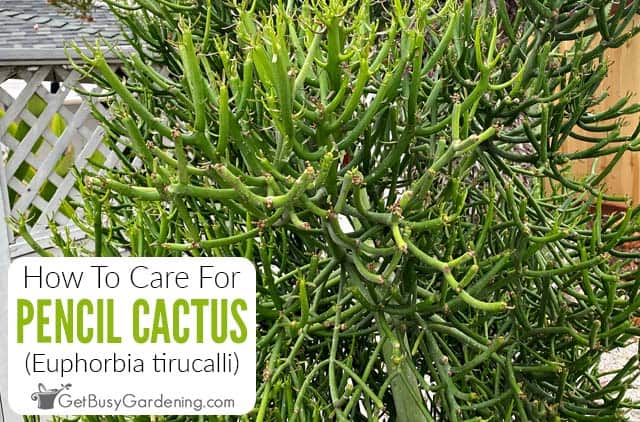
Pencil Cactus Quick Care Overview
| Scientific name: | Euphorbia tirucalli |
| Classification: | Succulent plant |
| Common names: | Pencil Cactus, Milk Bush, Finger Tree |
| Hardiness: | Zones 9-11 |
| Temperature: | 60-95°F (15.5-35°C) |
| Flowers: | Red, yellow, blooms late spring-summer |
| Light: | Full sun, bright light indoors |
| Water: | Allow soil to dry between drinks, do not overwater |
| Humidity: | Little to none |
| Fertilizer: | All-purpose organic fertilizer, spring-summer |
| Soil: | Fast-draining, sandy |
| Common pests: | Mealybugs, spider mites, aphids |
Information About Pencil Cactus
Despite its name, the pencil cactus (Euphorbia tirucalli) is actually a succulent plant native to India and South Africa.
It features clumps of thin, stick-like branches that grow out from a thick central stem, earning it the common names of finger tree, pencil tree, and pencil cactus.
The other nickname, milk bush, comes from the white sap inside of it that bleeds out when the branches are cut or injured.
They can be green, red, or yellow, depending on variety, and reach heights of 30’ outdoors, or up to 6’ indoors.
As it ages the mature branches become brown and bark-like. With the right care a pencil cactus can live for 50 years or more.
Different Pencil Cactus Varieties
There are many plants that look similar to a pencil cactus, but there are only two true types: the common pencil cactus and the firestick plant, which is a cultivar.
Both are Euphorbia tirucalli and require the same care, but the firestick branches will turn a vibrant reddish yellow when exposed to full sun.
Flowers
A pencil cactus can produce clusters of tiny red or yellow flowers at the tips of the branches during late spring or summer, though it’s very uncommon on indoor plants.
The blossoms are insignificant and have no aroma, but are attractive to pollinators, like bees and butterflies.
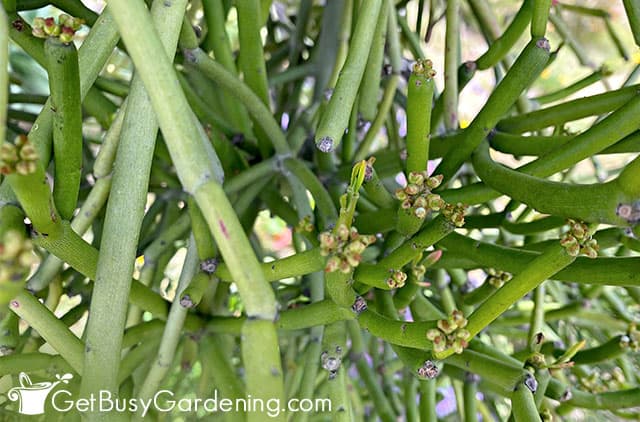
Toxicity
According to the ASPCA website the milky sap inside of pencil cacti can be irritating to the skin and toxic in the eyes or if it’s ingested.
Keep it well out of reach of kids and pets, and always where safety glasses and gloves while pruning.
How To Grow Pencil Cactus
Before we jump into the details about pencil cactus care, first we should chat about where to grow them. Choosing the right spot is key to maintaining a thriving, happy plant.
Hardiness
Pencil cactus plants are not cold hardy and will only survive outdoors year round in zones 9-11.
If you live in a climate that experiences freezing temperatures, keep yours in a container and move it indoors for the winter, or grow it as a houseplant all year.
Where To Grow Euphorbia tirucalli
The best place to grow a pencil cactus is somewhere with lots of light. A full sun location in the garden or a south or west-facing window indoors is ideal.
Choose a container with drainage to avoid overwatering, which can quickly cause it to rot. Look for a spot with good air circulation and avoid high humidity.

Pencil Cactus Plant Care & Growing Instructions
Now that you have the ideal place in mind to grow yours, it’s time to talk about pencil cactus care. The tips below will help you create the perfect environment for yours to thrive.
Light
Pencil trees love lots of light and prefer a spot with bright, direct sun all day long. If a west or south-facing window isn’t possible, or you notice leggy growth, add a grow light to supplement indoors.
Low light conditions or full shade will stunt their growth, and can also cause leggy or sparse branches.
Water
Euphorbia tirucalli are drought tolerant plants often used for landscaping in arid, warm regions. They do not like to be overwatered and won’t tolerate soggy feet for long.
Good drainage is key to providing the proper care for your pencil cactus. Always let the soil dry out between waterings. Then give it a deep drink and drain off all excess water from the pot.
If you struggle to get it right a soil moisture gauge is a helpful, inexpensive tool that will help you out.
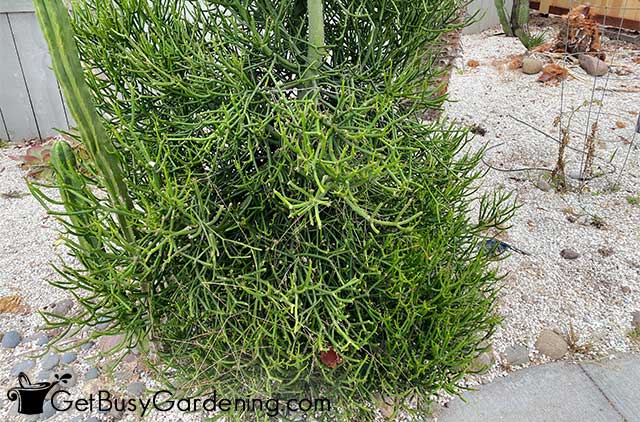
Temperature
The ideal temperature range for a pencil cactus is between 60-95°F (15.5-35°C).
They can tolerate lows of 50°F (10°C), but they won’t grow much until it warms up. Anything below freezing will damage or eventually kill the plant.
They can handle highs of over 100°F (37.7°C), but they may require more frequent watering, and the branches can start to burn if high temps are prolonged.
Fertilizer
A pencil cactus doesn’t require frequent feedings as part of their regular care, but occasional fertilizer can stimulate new growth.
Choose an organic, balanced option. It can be a general liquid fertilizer, compost tea or fish emulsion, or you can apply slow-release granules.
Dilute the liquids by half and apply them once per season in the spring and summer. For granules, top-dress only once per year at the beginning of spring.
Soil
The best soil for a pencil cactus is something sandy and well-draining, but they’re not picky. Just avoid mixes that contain water retentive ingredients.
A porous potting soil is a good choice, or you can amend a general purpose mix with coarse sand and perlite or pumice to improve drainage.
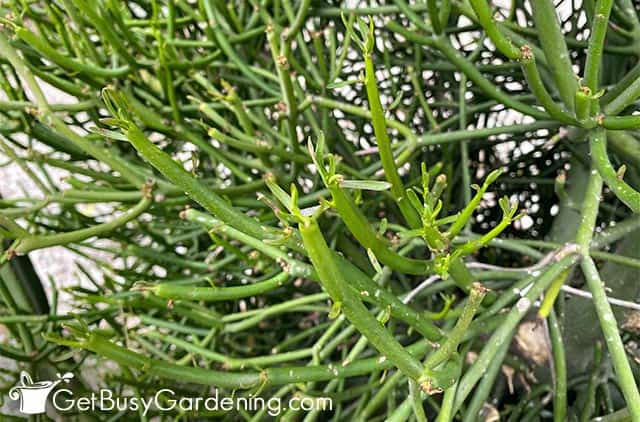
Transplanting & Repotting
When Euphorbia turicalli are young, they may need to be repotted every 1-2 years, but their growth slows with maturity.
Roots growing out of the drainage holes or stalled growth are signs that it’s time to size up.
When it’s time to pot them up, move them into a container that’s 1-2” larger than the current one. Be sure to handle them gently and wear gloves and eye protection to protect yourself from the sap.
Pruning
Consistent pruning is an important part of pencil cactus care, and it will keep your plant bushier.
It’s best to tackle it in early spring before the plant begins to put on new growth. You can remove dead or damaged branches throughout the year as needed.
Use micro snips or precision pruners to cut back leggy or tall growth, or heavy duty shears for thicker branches.
Always wear eye protection and gloves when making cuts to prevent the milky sap from getting on your skin or in your eyes.
It’s helpful to have a bottle of water nearby so you can spray the cuts and stop the flow of sap.
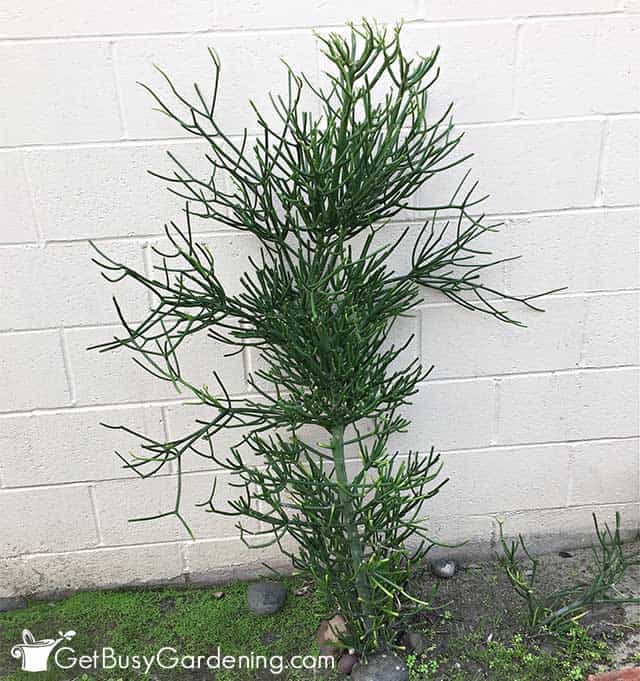
Pest Control Tips
Well-cared for and healthy pencil cactus plants are mostly pest free, but they can occasionally be affected by mealybugs, spider mites, or aphids.
If you see any bugs, isolate your plant and treat them right away. Apply rubbing alcohol using a cotton swab to kill any visible insects.
Then spray your plant with a neem oil solution or insecticidal soap. I make my own by mixing 1 teaspoon of mild liquid soap with 1 liter of water.
Pencil Cactus Propagation Tips
The best way to propagate a pencil cactus is by rooting cuttings. Use pruners or micro snips to cut a healthy 3-5” branch, and dip the cut end in water to stop the sap from flowing.
Let it dry until the end forms a callus so the cutting doesn’t rot. Then apply rooting hormone to help speed up the process, and gently plant it in a loose, fast-draining medium.
Keep the soil only lightly moist, put the cutting in bright light until new growth begins, then pot it up.
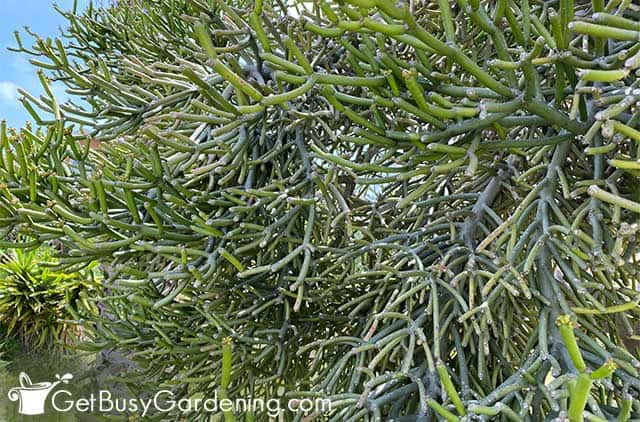
Troubleshooting Common Pencil Cactus Problems
Pencil cactus is often low-maintenance and easy to care for, but no plant is completely problem-free. If you encounter one of these more common issues, my tips can help you get it back on track.
Dropping Branches
Cold temperatures, overwatering, and natural aging are all reasons your pencil cactus might drop branches.
Avoid exposing them to temperatures below 50°F (10°C) and give them a deep, thorough drink only when the soil is dry. Always drain off any excess water.
If your Euphorbia tirucalli appears healthy and occasionally loses a branch, it’s nothing to worry about. This is a natural part of a maturing plant.
Plant Shriveling
Shriveling branches is usually a sign of underwatering. The branches will appear droopy, dried, and deflated.
While pencil cacti are drought tolerant, they do require some water to survive. Use a soil moisture gauge to monitor the level, and give it a deep drink when it gets dry.
However root rot can also cause the branches to shrivel, so be sure to check the base of the main stem for signs of rot and ensure the soil is dry at least 2″ deep before giving it more water.
Branches / Leaves Turning Yellow
If your pencil cactus has yellowing branches or leaves, it’s usually an indication that it’s been overwatered. But this can also be a normal sign of aging.
The occasional yellow branch or leaf is not a concern. It happens as branches age, and they will eventually fall off.
If several are beginning to change color, or they are also mushy, wet, or drooping, it’s a sign of too much water. Allow the soil to dry out more between drinks.
Pencil Cactus Turning Brown
Browning leaves or branches could be caused by over or under watering or extreme heat. The soil should never be soggy, but it shouldn’t be left bone-dry for long periods either.
Extreme temperatures of 100°F (37.7°C) or more in direct sun can cause sunburn from time to time.
It can also happen when an indoor plant hasn’t been properly transitioned to the direct sun outdoors. Instead, gradually expose it over the course of a few weeks to allow it time to adjust.
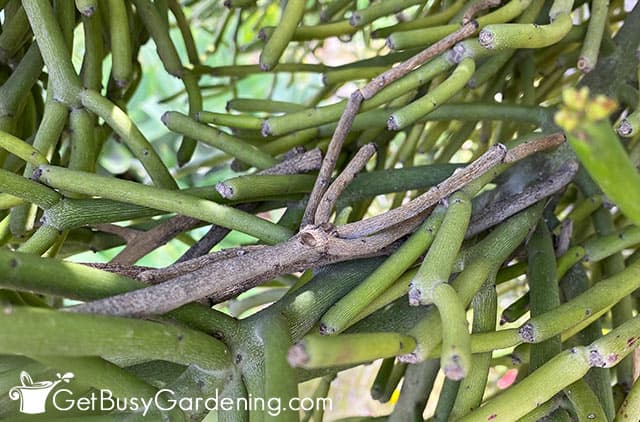
FAQs
Here I’ve answered some of the most commonly asked questions about pencil cactus care. If yours isn’t listed here, please add it to the comments section below.
Is pencil cactus easy to grow?
A pencil cactus is easy to grow if you can provide plenty of bright light, well-draining soil, and warmth, and avoid overwatering.
Can a pencil cactus survive indoors?
Yes, a pencil cactus can survive very well indoors and make great houseplants as long as they receive 6-8 hours of bright or direct light a day. Grow lights are a great tool for keeping them happy inside.
Why is my pencil cactus dying?
A dying pencil cactus can be caused by a variety of issues, like lack of light, cold temperatures, overwatering, or extreme drought. Give them lots of warmth, bright light, and water only when the soil is dry.
Is pencil cactus fast growing?
Pencil cactus plants grow quickly in the first few years, then tend to slow down as they mature. Repotting into a larger container, pruning, full sun, and fertilizing are good ways to stimulate new growth.
Can you touch a pencil cactus?
Yes you can touch a pencil cactus, but the milky sap inside the branches can be a skin and eye irritant. Wear gloves and eye protection when pruning or propagating it, and spray the cuts with water to stop the sap flow.
Is a pencil cactus the same as Firestick?
Pencil cactus and firestick plants are two different varieties of Euphorbia tirucalli. The pencil cactus is green, while the firestick, which is a cultivar, has yellow-red branches when exposed to bright sunlight and cooler temps.
If you want to learn all there is to know about maintaining healthy indoor plants, then you need my Houseplant Care eBook. It will show you everything you need to know about how to keep every plant in your home thriving. Download your copy now!
More Houseplant Care Guides
- How To Grow & Care For An African Milk Tree
- How To Care For An Orchid Cactus Plant (Epiphyllum)
- How To Care For Fishbone Cactus (Selenicereus anthonyanus)
- How To Care For Kalanchoe Plants
- Growing Plants Indoors – The Ultimate Guide
Share your pencil cactus care tips in the comments section below.

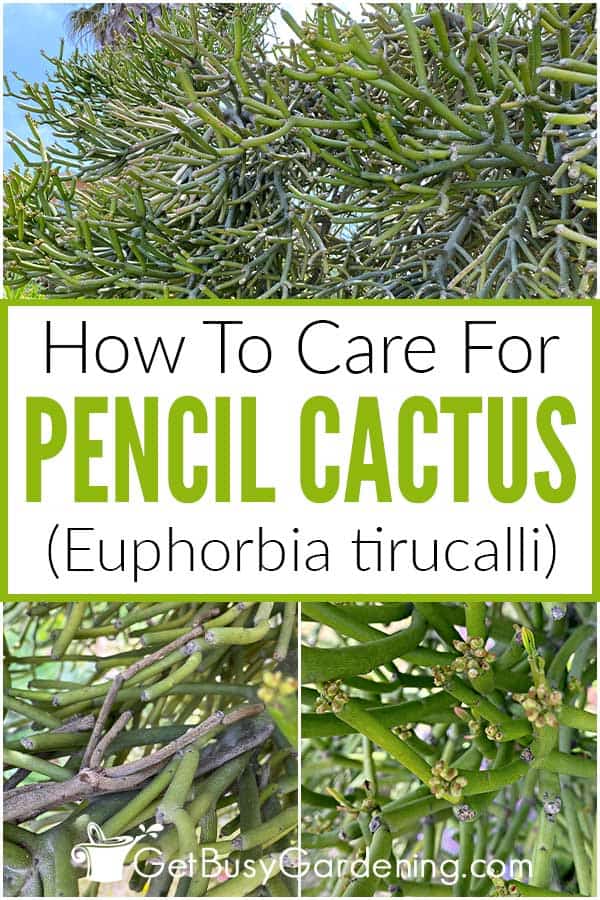
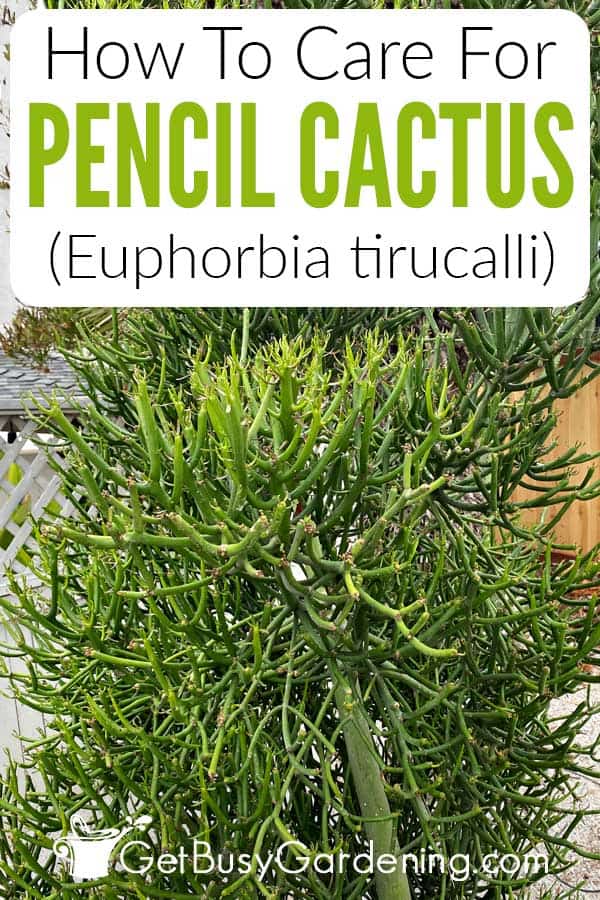


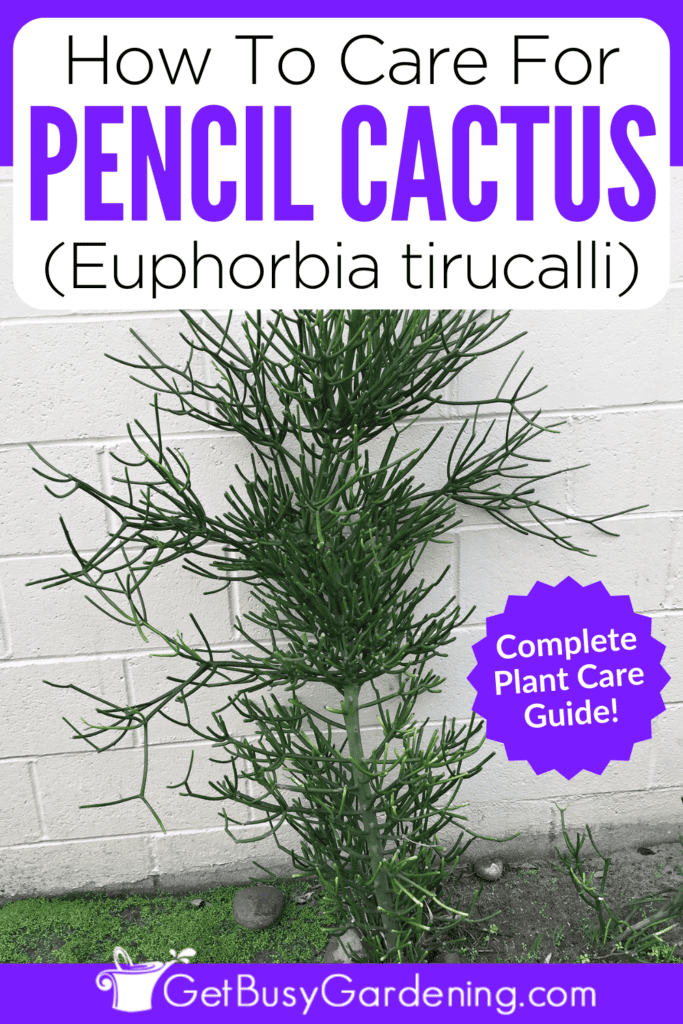

Lynette Woodward says
I need advice about Firestick pencil plant. I live in Zone 9 near Orlando, FL.
I was gifted this small plant which is now enormous, bent over from growth, outside always in a big pot. Protected from Temps in the high 30’s last night. Root grew into ground, got pulled out today while trying to assess situation. I don’t have a green thumb.article was great, but don’t know what to do.
Amy Andrychowicz says
If I were you, I would plant your pencil cactus into the ground, since it seems to really like the location you have it growing. Otherwise, it definitely needs to be transplanted into a larger pot. Here’s my complete guide for how to care for firestick plants.